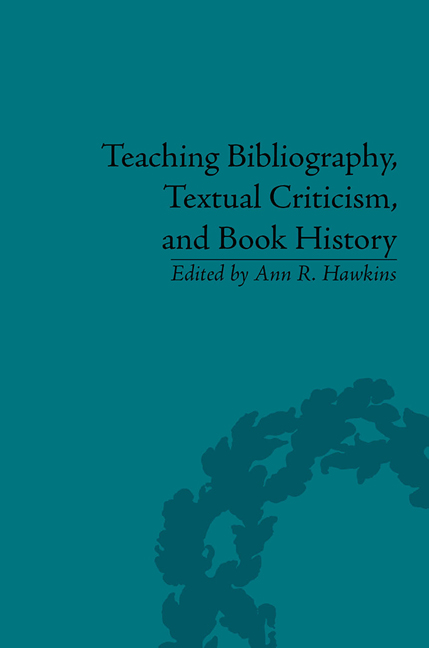Book contents
- Frontmatter
- Contents
- Notes on Contributors
- Foreword
- Introduction: Towards a pedagogy of Bibliography
- Part I Rationales
- Part II Creating and Using Resources
- Part III Methodologies
- Teaching ‘History of the Book’
- Teaching Bibliography and Research Methods
- The Bibliography and Research Course
- Integrating ‘Bibliography’ with ‘Literary Research’: A Comprehensive Approach
- The Hidden Lives of Books
- Learning from Binders: Investigating the Bookbinding Trade in Colonial Philadelphia
- Papermaking, History and Practice
- The Bibliographical Analysis of Antique Laid Paper: A Method
- Teaching Textual Criticism
- Part V Resources
- Index
Integrating ‘Bibliography’ with ‘Literary Research’: A Comprehensive Approach
from Teaching Bibliography and Research Methods
- Frontmatter
- Contents
- Notes on Contributors
- Foreword
- Introduction: Towards a pedagogy of Bibliography
- Part I Rationales
- Part II Creating and Using Resources
- Part III Methodologies
- Teaching ‘History of the Book’
- Teaching Bibliography and Research Methods
- The Bibliography and Research Course
- Integrating ‘Bibliography’ with ‘Literary Research’: A Comprehensive Approach
- The Hidden Lives of Books
- Learning from Binders: Investigating the Bookbinding Trade in Colonial Philadelphia
- Papermaking, History and Practice
- The Bibliographical Analysis of Antique Laid Paper: A Method
- Teaching Textual Criticism
- Part V Resources
- Index
Summary
ENGL 603, Bibliography and Literary Research, introduces Texas A & M English graduate students to a wide range of topics and issues:
• MLA documentation format
• print and electronic reference sources in English and the humanities
• The special characteristics of humanities research
• The history of books and printing
• Enumerative, analytical, and descriptive bibliography
• Editorial theory and practice
The course's title, as well as this laundry list of contents, raises a question that we pursue throughout the semester: what is the relationship between ‘bibliography’ and ‘literary research’? To the extent that the course covers enumerative or reference bibliography, the answer seems obvious; students understand that they need to know how to use major serial bibliographies and other secondary sources. But the relevance of other forms of bibliography is less easily understood by students who have never thought about the process by which the texts they study became books. The lack of exposure to bibliography, textual scholarship, and the history of the book among English graduate students should come as no surprise; as Jerome McGann has observed (in an essay that is required reading for my students), these fields have been marginalized within english studies for some time.
- Type
- Chapter
- Information
- Teaching Bibliography, Textual Criticism, and Book History , pp. 117 - 123Publisher: Pickering & ChattoFirst published in: 2014



